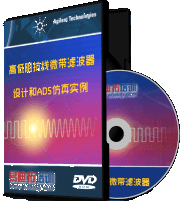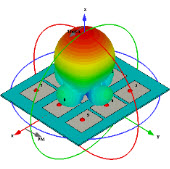Re:求助!FDTD:Sullivan书中程序FD1D_2.2.c有个地方没懂
05-08
程序中在对Ex进行傅里叶变换之后加红那段对入射脉冲作傅里叶变换的if语句有什么意义?
为什么乘的是ex[10]而不是加入脉冲的位置的ex[5]?
T<100在这里又怎么解释?求各位指教,小弟初学,先谢过了。
# include <math.h>
# include <stdlib.h>
# include <stdio.h>
# define KE 200 /* KE is the number of cells to be used */
void main ()
{
float dx[KE], ex[KE], hy[KE], ix[KE];
float ga[KE],gb[KE];
int n,m,k,kc,ke,kstart,NSTEPS;
float T,ddx,dt,epsz,epsilon,sigma;
float t0,spread,pi,pulse;
FILE *fp;
float ex_low_m1,ex_low_m2,ex_high_m1,ex_high_m2;
float real_pt[5][KE],imag_pt[5][KE];
float freq[5],arg[5],ampn[5][KE],phasen[5][KE];
float real_in[5],imag_in[5],amp_in[5],phase_in[5];
// float mag[KE];
pi = 3.14159;
kc = KE/2; /* Center of the problem space*/
ddx = .01; /* Cell size */
dt = ddx/6e8; /* Time steps */
epsz = 8.8e-12;
printf (" %6.4f %10.5e \n",ddx,dt);
/*Initialize to free space */
for (k = 0; k <KE; k++)
{
ga[k] = 1.;
gb[k] = 0.;
ex[k] = 0;
dx[k] = 0;
hy[k] = 0;
ix[k] = 0;
// mag[k] = 0;
for (m=0; m<=2; m++)
{
real_pt[m][k] = 0; /* Real and imaginary parts of Fourier Transform */
imag_pt[m][k] = 0;
ampn[m][k] = 0; /* Amplitude and phase of the Fourier Transforms */
phasen[m][k] =0;
}
}
for ( m=0; m<=2; m++)
{
real_in[m] = 0; /* Fourier Trans of input pulse */
imag_in[m] = 0;
}
ex_low_m1=0;
ex_low_m2=0;
ex_high_m1=0;
ex_high_m2=0;
/* Parameters for the Fourier Transform */
freq[0] = 100.e6;
freq[1] = 200.e6;
freq[2] = 500.e6;
for (n=0; n<=2; n++)
{
arg[n] = 2*pi*freq[n]*dt;
printf ("%2d %6.2f %7.5f \n",n,freq[n]*1e-6,arg[n]);
}
printf ("Dielectric starts at -->");
scanf ("%d",&kstart);
printf ("Epsilon -->");
scanf ("%f",&epsilon);
printf ("Conductivity -->");
scanf ("%f",&sigma);
printf ("%d %6.2f %6.2f \n",kstart,epsilon,sigma);
/* Initialize the parameters */
for (k=kstart; k<KE; k++)
{
ga[k] = 1./(epsilon+sigma*dt/epsz);
gb[k] = sigma*dt/epsz;
}
for (k=1; k<KE; k++)
{
printf ("%2d ga[k]=%4.2f gb[k]=%4.2f\n",k,ga[k],gb[k]);
}
/* These parameters specify the input pulse */
t0=50.0; /* Center of the incident pulse */
spread=10.0; /* Width of the incident pulse */
T=0;
NSTEPS=1;
while ( NSTEPS>0)
{
/* Main part of the program */
printf ("NSTEPS --> "); /* NSTEPS is the number of times the */
scanf (" %d", &NSTEPS); /* main loop has executed */
printf (" %d \n",NSTEPS);
for (n=1; n<=NSTEPS; n++)
{
T=T+1; /* T keeps track of the total number */
/* of times the main loop is executed */
/* Main FDTD Loop */
/* Calculate the Dx field */
for (k=1; k<KE; k++)
{
dx[k] = dx[k] +.5*(hy[k-1]-hy[k]);
}
/* Initialize with a Guassian pulse */
pulse = exp(-.5*(pow( (t0-T)/spread,2.0) ));
dx[5] = dx[5] + pulse;
printf ("%5.1f %6.2f %6.2f\n",T,pulse,dx[5]);
/* Calculate Ex from Dx */
for ( k=1; k<KE;k++)
{
ex[k] = ga[k]*(dx[k] - ix[k]);
ix[k] = ix[k] + gb[k]*ex[k];
}
/* Calculate the Fourier transform of Ex. */
for ( k=0;k<KE;k++)
{
for (m=0;m<=2;m++)
{
real_pt[m][k] = real_pt[m][k] + cos(arg[m]*T)*ex[k];
imag_pt[m][k] = imag_pt[m][k] - sin(arg[m]*T)*ex[k];
}
}
/* Fourier Transform of the input pulse */
if (T<100)
{
for (m=0; m<=2; m++)
{
real_in[m] = real_in[m] + cos (arg[m]*T)*ex[10];
imag_in[m] = imag_in[m] - sin (arg[m]*T)*ex[10];
}
}
/*Absorbing Boundary Conditions*/
ex[0] = ex_low_m2;
ex_low_m2 = ex_low_m1;
ex_low_m1 = ex[1];
ex[KE-1] = ex_high_m2;
ex_high_m2 = ex_high_m1;
ex_high_m1 = ex[KE-2];
/* Calculate the Hy field */
for ( k=0; k<KE-1; k++)
{
hy[k] = hy[k] + .5*(ex[k]-ex[k+1]);
}
}
/* End of the Main FDTD Loop */
/* At the end of the calculation,print out
the Ex and Hy fields */
for (k=0; k<KE; k++)
{
printf ("%2d %6.2f %6.2f \n",k,dx[k],ex[k]);
}
/* Write the E field out ot a file "Ex" */
fp=fopen( "Ex","w");
for (k=0;k<KE;k++)
{
fprintf (fp," %6.3f \n",ex[k]);
}
fclose(fp);
/* Calculate the amplitude and phase of each frequency */
/* Amplitude and phase of the input pulse */
for ( m=0; m<=2; m++)
{
amp_in[m] = sqrt (pow (imag_in[m],2) + pow(real_in[m],2));
phase_in[m] = atan2 (imag_in[m],real_in[m]);
printf ( "%d Input Pulse : %8.4f %8.4f %8.4f %7.2f \n",
m,real_in[m],imag_in[m],amp_in[m],(180.0/pi)*phase_in[m]);
for ( k=0; k<KE; k++)
{
ampn[m][k] = (1./amp_in[m])*sqrt( pow(real_pt[m][k],2.)
+ pow(imag_pt[m][k],2.));
phasen[m][k] = atan2(imag_pt[m][k],real_pt[m][k])
-phase_in[m];
}
}
/* Write the amplitude field out to a files "Amp" */
fp=fopen( "Amp0","w");
for (k=0;k<KE;k++)
{
fprintf (fp," %8.5f \n",ampn[0][k]);
}
fclose(fp);
fp=fopen( "Amp1","w");
for (k=0;k<KE;k++)
{
fprintf (fp," %8.5f \n",ampn[1][k]);
}
fclose(fp);
fp=fopen( "Amp2","w");
for (k=0;k<KE;k++)
{
fprintf (fp," %8.5f \n",ampn[2][k]);
}
fclose(fp);
printf("%5.1f \n",T);
}
}
为什么乘的是ex[10]而不是加入脉冲的位置的ex[5]?
T<100在这里又怎么解释?求各位指教,小弟初学,先谢过了。
# include <math.h>
# include <stdlib.h>
# include <stdio.h>
# define KE 200 /* KE is the number of cells to be used */
void main ()
{
float dx[KE], ex[KE], hy[KE], ix[KE];
float ga[KE],gb[KE];
int n,m,k,kc,ke,kstart,NSTEPS;
float T,ddx,dt,epsz,epsilon,sigma;
float t0,spread,pi,pulse;
FILE *fp;
float ex_low_m1,ex_low_m2,ex_high_m1,ex_high_m2;
float real_pt[5][KE],imag_pt[5][KE];
float freq[5],arg[5],ampn[5][KE],phasen[5][KE];
float real_in[5],imag_in[5],amp_in[5],phase_in[5];
// float mag[KE];
pi = 3.14159;
kc = KE/2; /* Center of the problem space*/
ddx = .01; /* Cell size */
dt = ddx/6e8; /* Time steps */
epsz = 8.8e-12;
printf (" %6.4f %10.5e \n",ddx,dt);
/*Initialize to free space */
for (k = 0; k <KE; k++)
{
ga[k] = 1.;
gb[k] = 0.;
ex[k] = 0;
dx[k] = 0;
hy[k] = 0;
ix[k] = 0;
// mag[k] = 0;
for (m=0; m<=2; m++)
{
real_pt[m][k] = 0; /* Real and imaginary parts of Fourier Transform */
imag_pt[m][k] = 0;
ampn[m][k] = 0; /* Amplitude and phase of the Fourier Transforms */
phasen[m][k] =0;
}
}
for ( m=0; m<=2; m++)
{
real_in[m] = 0; /* Fourier Trans of input pulse */
imag_in[m] = 0;
}
ex_low_m1=0;
ex_low_m2=0;
ex_high_m1=0;
ex_high_m2=0;
/* Parameters for the Fourier Transform */
freq[0] = 100.e6;
freq[1] = 200.e6;
freq[2] = 500.e6;
for (n=0; n<=2; n++)
{
arg[n] = 2*pi*freq[n]*dt;
printf ("%2d %6.2f %7.5f \n",n,freq[n]*1e-6,arg[n]);
}
printf ("Dielectric starts at -->");
scanf ("%d",&kstart);
printf ("Epsilon -->");
scanf ("%f",&epsilon);
printf ("Conductivity -->");
scanf ("%f",&sigma);
printf ("%d %6.2f %6.2f \n",kstart,epsilon,sigma);
/* Initialize the parameters */
for (k=kstart; k<KE; k++)
{
ga[k] = 1./(epsilon+sigma*dt/epsz);
gb[k] = sigma*dt/epsz;
}
for (k=1; k<KE; k++)
{
printf ("%2d ga[k]=%4.2f gb[k]=%4.2f\n",k,ga[k],gb[k]);
}
/* These parameters specify the input pulse */
t0=50.0; /* Center of the incident pulse */
spread=10.0; /* Width of the incident pulse */
T=0;
NSTEPS=1;
while ( NSTEPS>0)
{
/* Main part of the program */
printf ("NSTEPS --> "); /* NSTEPS is the number of times the */
scanf (" %d", &NSTEPS); /* main loop has executed */
printf (" %d \n",NSTEPS);
for (n=1; n<=NSTEPS; n++)
{
T=T+1; /* T keeps track of the total number */
/* of times the main loop is executed */
/* Main FDTD Loop */
/* Calculate the Dx field */
for (k=1; k<KE; k++)
{
dx[k] = dx[k] +.5*(hy[k-1]-hy[k]);
}
/* Initialize with a Guassian pulse */
pulse = exp(-.5*(pow( (t0-T)/spread,2.0) ));
dx[5] = dx[5] + pulse;
printf ("%5.1f %6.2f %6.2f\n",T,pulse,dx[5]);
/* Calculate Ex from Dx */
for ( k=1; k<KE;k++)
{
ex[k] = ga[k]*(dx[k] - ix[k]);
ix[k] = ix[k] + gb[k]*ex[k];
}
/* Calculate the Fourier transform of Ex. */
for ( k=0;k<KE;k++)
{
for (m=0;m<=2;m++)
{
real_pt[m][k] = real_pt[m][k] + cos(arg[m]*T)*ex[k];
imag_pt[m][k] = imag_pt[m][k] - sin(arg[m]*T)*ex[k];
}
}
/* Fourier Transform of the input pulse */
if (T<100)
{
for (m=0; m<=2; m++)
{
real_in[m] = real_in[m] + cos (arg[m]*T)*ex[10];
imag_in[m] = imag_in[m] - sin (arg[m]*T)*ex[10];
}
}
/*Absorbing Boundary Conditions*/
ex[0] = ex_low_m2;
ex_low_m2 = ex_low_m1;
ex_low_m1 = ex[1];
ex[KE-1] = ex_high_m2;
ex_high_m2 = ex_high_m1;
ex_high_m1 = ex[KE-2];
/* Calculate the Hy field */
for ( k=0; k<KE-1; k++)
{
hy[k] = hy[k] + .5*(ex[k]-ex[k+1]);
}
}
/* End of the Main FDTD Loop */
/* At the end of the calculation,print out
the Ex and Hy fields */
for (k=0; k<KE; k++)
{
printf ("%2d %6.2f %6.2f \n",k,dx[k],ex[k]);
}
/* Write the E field out ot a file "Ex" */
fp=fopen( "Ex","w");
for (k=0;k<KE;k++)
{
fprintf (fp," %6.3f \n",ex[k]);
}
fclose(fp);
/* Calculate the amplitude and phase of each frequency */
/* Amplitude and phase of the input pulse */
for ( m=0; m<=2; m++)
{
amp_in[m] = sqrt (pow (imag_in[m],2) + pow(real_in[m],2));
phase_in[m] = atan2 (imag_in[m],real_in[m]);
printf ( "%d Input Pulse : %8.4f %8.4f %8.4f %7.2f \n",
m,real_in[m],imag_in[m],amp_in[m],(180.0/pi)*phase_in[m]);
for ( k=0; k<KE; k++)
{
ampn[m][k] = (1./amp_in[m])*sqrt( pow(real_pt[m][k],2.)
+ pow(imag_pt[m][k],2.));
phasen[m][k] = atan2(imag_pt[m][k],real_pt[m][k])
-phase_in[m];
}
}
/* Write the amplitude field out to a files "Amp" */
fp=fopen( "Amp0","w");
for (k=0;k<KE;k++)
{
fprintf (fp," %8.5f \n",ampn[0][k]);
}
fclose(fp);
fp=fopen( "Amp1","w");
for (k=0;k<KE;k++)
{
fprintf (fp," %8.5f \n",ampn[1][k]);
}
fclose(fp);
fp=fopen( "Amp2","w");
for (k=0;k<KE;k++)
{
fprintf (fp," %8.5f \n",ampn[2][k]);
}
fclose(fp);
printf("%5.1f \n",T);
}
}
相关文章:
- 请问:很多微带线的FDTD参数提取的程序中为何不用PML(05-08)
- 有没有大型稀疏矩阵压缩存贮的子程序?(05-08)
- 急求复数矩阵SVD源程序(05-08)
- Schneider博士的FDTD示例 C程序(05-08)
- 哪里有计算矩量法中sommerfeld积分的程序?(05-08)
- 现在正在编写一个有关波导本征值计算的程序(05-08)
射频专业培训教程推荐











